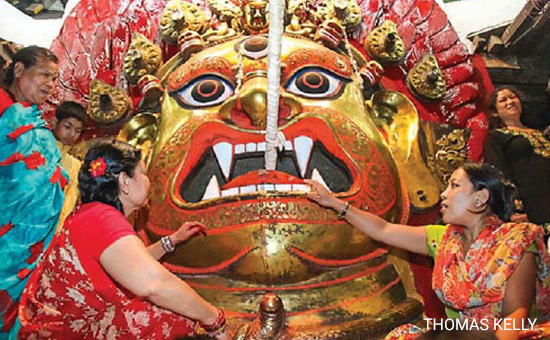- Hindus and Buddhists join together in a 400-year-old
celebration that invokes divine blessings through giant Deities and a
sanctified little girl.
This article is "Courtesy Hinduism Today magazine, Hawaii".
In Nepal’s Kathmandu Valley, The beliefs and practices of Hinduism and Buddhism weave together like the intertwined scrollwork on Kathmandu’s elaborate temples. A perfect manifestation of this harmony is Indra Jatra, one of Nepal’s most iconic festivals.
Like much of Kathmandu’s ritual and artistic culture, this festival originates with the city’s ethnic Newar community. Statistically, the Newars are 85 percent Hindu and 15 percent Buddhist. But their practice and belief are inclusive; and they share the celebration of the many forms of Divinity.
The Indra Jatra is
said to date back over 1,200 years to the eighth century. The traditions behind
it are distinctly Hindu. The eight-day jatra (festival) is
dedicated to Indra, the Rain God, as an offering of
thanks for the monsoon and the coming harvest. As masked dancers whirl
to drums and cymbals, chariots carrying murtis (physical images) of two Hindu Gods—Ganesha and the fierce Bhairav manifestation of Siva—are hauled by human muscle through the streets. The crowning moment is when the Kumari, Kathmandu’s “living Goddess,” who is said to embody a form of Durga, makes one of her rare public appearances in an immense chariot of her own.
So far, it sounds Hindu. But inside the chariots the Deities are embodied by Buddhist children. Two boys are chosen as Bhairav and Ganesh, while a Buddhist girl is selected at around the age of four as Kathmandu’s famous Kumari, residing until adolescence in a temple-palace on Durbar Square. There she is worshiped daily and, on Indra Jatra, places tika (forehead mark)
on the head of state, who until recently was a Hindu king, to legitimize his
rule for one more year.
A colorful tale explains the festival’s origins. Indra Himself, the legend goes, came to Kathmandu in search of a jasmine flower (parijat) for his mother, Bashundara, who needed it for a ritual. As he plucked it near Durbar Square, the locals mistook him for a thief and placed him to prison. His distraught mother soon came in search of him, as did his trusty elephant. When the people realized whom they had captured, they sheepishly released the God. The festival winds through the city in a re-enactment of the search by Indra’s mother, played by a masked dancer, and by Indra’s elephant, created out of wicker.
The original
effort to praise (and perhaps apologize to) Indra grew and expanded over the
centuries. It now includes worship of Bhairav to
bring luck and protection for the coming year. By the mid-1700s, the
festival had merged with the ritual blessing of the king for the coming year by
the Kumari.
The origins of the
Kumari ritual are not precisely known. One former Kumari, Rashmila Shakya,
favors the theory that there was once a small girl who behaved rudely to the
king, claiming to be a Goddess. When he arrogantly banished her and her family,
the queen became ill. Realizing his mistake, the king called her back and
recognized her as an emanation of Taleju, a local form of Durga. In another
version, the Goddess used to appear in Her divine form to the king, but he
insulted her by making a pass at her. She later agreed to come back, but only
in the form of a young virgin.
 Swet-Bhairav is revealed only once a year.
Swet-Bhairav is revealed only once a year.
Full caption - Sve-Bhairav usually
concealed behind a grille at an open-air shrine, is revealed only once a year,
when devotees worship Him and some take rice liquor prasad from the pipe in His
mouth.
Which king first began the ceremonial Kumari worship and in which time period? The proposed dates range from as early as 1615 to as late as 1768. The latter date, though, seems unlikely, being barely a dozen years before the conquest of Kathmandu by Prithvi Narayan Shah. By that time, belief in the importance of the Kumari’s blessing of the head of state was so solidly entrenched among the people that the Shah timed his invasion to coincide with the wild festivities of Indra Jatra—and made a special point of receiving tika from the Kumari before the king of Kathmandu could bow to her. In effect, he won the war by receiving the blessings of the Goddess.
Kumari worship has long demonstrated the mingling of Newar Hinduism and
Buddhism. As Rashmila Shakya, the former Kumari, put in her 2005 autobiography, From Goddess to Mortal: “Some of us are Buddhist and some are Hindu, and we are tolerant enough that I was to become the most prominent symbol of this tolerance.”
The interweaving of the two faiths is vast and complex. Not only the Kumari but other
Deities as well are regarded in different but complementary ways, according to
Badra Ratna Bajracharya, dean of Lumbini Buddhist University. Bhairav, for
instance, is worshiped by Buddhists as Mahakala. To Hindus that is one of the
many names of Siva; to Buddhists Mahakala is a Boddhisatva whose fierce
appearance expresses His role as a protector of the dharma. In other examples,
the Hindu Deity Pashupatinath is also worshiped as Buddha - and Buddhist
courtyards may contain a Krishna statue. Many local Deities are worshiped by
both groups under different names. Local festivals, as well, typically have
different but connected meanings to the two communities.
Each year, as the monsoon passes and the fields begin to sparkle, Kathmandu comes together to celebrate that shared heritage. Ask a person on the street during Indra Jatra which community the festival is for, and they’ll make no distinction. “It’s Hindu,” they’ll say. “But it’s also Buddhist. It’s mixed. God is one, so it’s for everyone.”
Author lives in Kathmandu where she is working
on a book.
First
published here